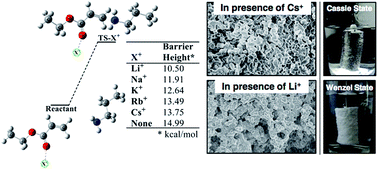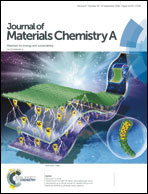Alkali metal-ion assisted Michael addition reaction in controlled tailoring of topography in a superhydrophobic polymeric monolith†
Abstract
In general, lotus leaf and rose petal-inspired wettabilities are artificially developed through the integration of hierarchical topography and essential chemical functionality. However, a fundamental and important aspect of this nature inspired wettability is not yet addressed; between the hierarchical topography and essential chemical modulation, which is the more sensitive parameter for this nature inspired special wettability? The design of a common approach for tailoring both the hierarchical topography and chemical functionalities is highly essential for investigating such a relevant fundamental aspect; however the synthesis of such a material is extremely difficult in reality. In the current computational study, the Michael addition reaction between unsaturated ester and primary amine groups was found to be facilitated in the presence of alkali metal ions. Interestingly, the mixture of branched polyethyleneimine (BPEI) and dipentaerythritol pentaacrylate (5Acl) in ethanol transformed into a chemically reactive polymeric monolith with tailored hierarchical features—based on the selection of appropriate alkali metal ions in the reaction mixture. The current study investigates the impact of the change in hierarchy in the topography on the nature inspired super-wettability—keeping the chemical functionality of the hierarchical topography intact. On the other hand, the inherent chemical reactivity of the hierarchical interfaces allowed us to examine the change in the chemical modulation—independently and precisely. The post-covalent modification of the hierarchical topography with longer and shorter hydrocarbon tails has a significant impact in controlling the metastable trapped air in the artificially biomimicked interfaces, and eventually controls the Wenzel, Cassie–Baxter and Cassie–Wenzel transition states. This current approach also allows us to modulate other relevant physical properties in the material—including the shrinkage of the material after the removal of the reaction solvent and compressive modulus. The materials with optimized physical properties were successfully exploited in the separation and collection of different forms of oil spills through both selective absorption process and gravity driven filtration process, even under practically relevant severe settings. Such a facile and general approach for tailoring both the chemical functionality and topography could be of potential interest for developing various functional and smart materials—including tissue engineering, patterned interfaces, etc.



 Please wait while we load your content...
Please wait while we load your content...